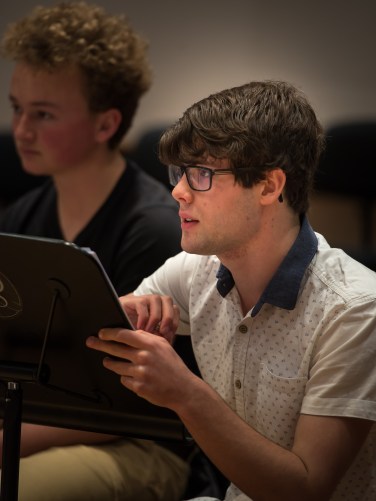
BY STEPHANIE ESLAKE
Leading Tasmanian composer and educator Maria Grenfell is working with budding new music makers in the coming months. Together, they’re crafting a series of works inspired by our environment, as part of the TSO Composers’ Project.
It’s the second year running for the Tasmanian Symphony Orchestra initiative, and last year young musos worked with the Tasmanian Museum and Art Gallery to create music based on three artworks on exhibit. TMAG was recently named the overall winner for its Tempest exhibition at the 2017 Museum and Galleries National Awards, and Maria says the Composers’ Project was an “important part of this outreach and the Tempest display”.
This year, young composers are working with scientific researchers from IMAS. Students from The Friends School, Launceston Church Grammar, Hobart College, Elizabeth College, and St Patricks College Launceston, are drawing musical ideas from the oceans and its creatures.
Maria, who worked to establish the project, says 10 volunteer players from the TSO will workshop and perform the pieces. Maria fills us in, and also talks us through her own music, which will be performed by the TSO this week.

Hi Maria, tells about the TSO Composers’ Project. What are the science stories that will set the foundations for this new music?
The three themes for the IMAS research are marine biodiversity, which is analysing marine zones around Australia and what’s in them; the amazing journey of the lobster larvae – the lifecycle of a lobster; and ocean eddies – an eddy is a cyclone underwater.
How do you know what research theme will translate into an exciting piece of music?
We thought some of them had sonic possibilities. Like the lifecycle of the rock lobster: you might be able to write a composition that starts out portraying how it grows, evolves and changes into something else. And when you think about composing, that’s what you think about doing to your piece. You think about how it changes and grows and becomes something different.
What are some of the instruments that will be used to tell these ocean tales?
We have four pieces that use percussion, and some of them are unpitched percussion. So it’s extra challenging in how they will need to portray a particular sound or particular event without using pitch: wooden sounds, skin sounds, prickly sounds, and different aspects of what you’re thinking about with fish under water, for example. Some of it is abstract, but it does give them a visual and aural departing point for starting a composition. It helps them with an idea.
How does the project help young composers?
They can use this composition as part of their folio for assessment, and they can hear their piece performed by professional musicians. They’re not having to scrape around for players and find instruments they want to write for but haven’t got access to. We’ve given them all that upfront. They learn that they can write things that are very much from their imagination, without worrying if it’s going to be too hard. So it’s a fantastic opportunity.

Why do you think it’s an important time to be drawing on environmental inspiration for music?
I think there’s a general awareness, particularly among young people, of the impacts of climate change and of humans on the earth and interacting with water, animals and the earth. And I think that’s a really good thing. We have got a generation now that has grown up with the concept of ‘be kind to the planet’.
Your own music to be performed in the upcoming Simple Gifts concert – your Spirals for clarinet and bassoon – was commissioned by the TSO. What’s it all about?
I was talking with the TSO and they said they’d intended to program a piece called Duett-Concertino by Richard Strauss for clarinet, bassoon strings, and harp. It’s the only piece in the repertoire for that instrumental combination. Some orchestras like to commission what they call a ‘companion piece’ that can be played on the same program by the same players, but it’s like a new piece that’s against the old piece.
How does it feel to have your new music performed by a professional orchestra?
I’m really looking forward to it. I always get nervous when I hear my own pieces being played, and especially if it’s an orchestra. But I really enjoyed writing this piece because I know it would be played beautifully. I’ve heard the TSO’s Andrew Seymour (clarinet) and Tahnee van Herk (bassoon) play it twice to me in my office at the University of Tasmania Conservatorium of Music. And they say, ‘Is this ok?’. And I’m sitting there going, ‘Yes, that’s fine!’. It was really fun, so I really hope they like it.
Maria’s piece Spirals will be performed by the TSO at 2.30pm on 25 June at the Federation Concert Hall as part of Simple Gifts. The TSO Composers’ Project music is being workshopped in the coming months, and a final presentation to family and friends will take place at IMAS in September.
You can also listen out for my chat with Maria that will be released on 23 June as part of the Making Conversation podcast series.
This story was originally published in Warp Magazine, June 2017.
Images supplied.







